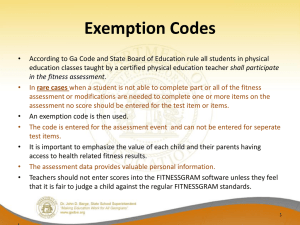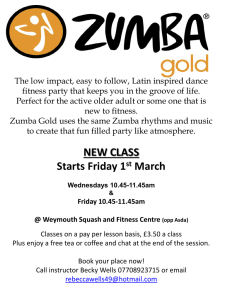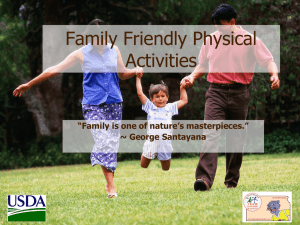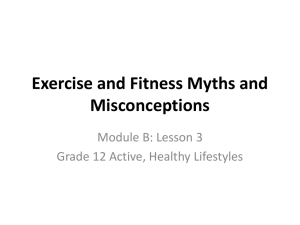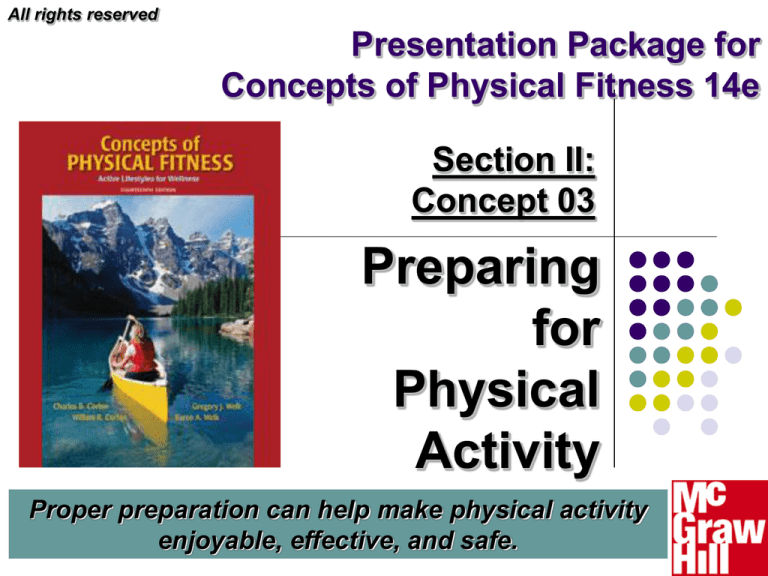
All rights reserved
Presentation Package for
Concepts of Physical Fitness 14e
Section II:
Concept 03
Preparing
for
Physical
Activity
Proper preparation can help make physical activity
Concepts of Physical Fitness 14e
enjoyable, effective,
and safe.
1
Factors to Consider Prior to
Physical Activity
Medical
readiness for physical
activity (PAR-Q)
Proper equipment and shoes
Concepts of Physical Fitness 14e
2
Click icon for more
info on ACSM
guidelines
ACSM Guidelines
Because of increased risk, certain
individuals should be given a graded
exercise test prior to performing vigorous
exercise:
Older individuals (men > 40 / women > 50)
Individuals with CHD risk factors
(Family history, high cholesterol, high blood pressure, sedentary
lifestyle, smoker, diabetic)
Concepts of Physical Fitness 14e
3
Clinical Exercise Test
(Stress Test)
A stress test can
determine
whether a person
can safely
perform exercise.
Concepts of Physical Fitness 14e
4
PAR-Q
Lab 3a info
P HYSICAL
A CTIVITY
R EADINESS
Q UESTIONNAIRE
Concepts of Physical Fitness 14e
5
Wearing Good Shoes is
Important
Running
Court
Aerobic
Walking
Tennis
Cross trainers
See Web03-2
Concepts of Physical Fitness 14e
6
Factors to Consider During
Daily Physical Activity
Importance of warm-up and cool-down for
reducing risk of injuries and soreness
Environmental factors
Concepts of Physical Fitness 14e
7
Components of a Workout
1.
2.
3.
Warm-up
Workout
Cool-down
Concepts of Physical Fitness 14e
8
Benefits of a Warm-up
Prepare cardiovascular system
Prepare metabolic system
Prepare musculoskeletal system
See Web03-4
Concepts of Physical Fitness 14e
9
Lab 3b
info
Components of a
Warm-up
Cardiovascular component
Flexibility component
Concepts of Physical Fitness 14e
10
Benefits of a Cool-down
Reduces blood pooling
Promotes recovery
Minimizes muscle
soreness
Concepts of Physical Fitness 14e
11
Exercising Safely in Different
Environments
Heat
Cold
Altitude
Pollution
See “On the Web” for
additional info
about all of these
Environments
Concepts of Physical Fitness 14e
12
Heat Related Illness
1.
2.
3.
Heat cramps
Heat exhaustion
Heat stroke
The severity of heat related
illness increases with
the degree of dehydration.
Concepts of Physical Fitness 14e
13
Exercise in the Heat
Avoid high heat/humidity
Replace fluids
Gradual exposure
(acclimatization)
Dress properly
Rest frequently
Watch for signs
See Web03-5
See Web03-6
Concepts of Physical Fitness 14e
14
Exercise in the Cold
Wind-chill
factor
Dress in layers
See Web03-7
Concepts of Physical Fitness 14e
15
Effects of Altitude
Lower partial pressure of
oxygen leads to
shortness of breath
Cold, dry air promotes
dehydration
Acute mountain sickness
See Web03-8
Concepts of Physical Fitness 14e
16
Pollution Indices
Ozone
Pollutants
Allergies
See Web03-9
for pollution info
Concepts of Physical Fitness 14e
17
DOMS
Delayed-onset muscle soreness.
24-48 hrs after intense exercise.
NOT caused by lactic acid.
Caused by microscopic muscle tears
resulting from excessive loads on the
muscles.
Occurs when you violate the principle of
progression. (to be discussed in future concept)
See Web03-10
Concepts of Physical Fitness 14e
18
Common Injuries
Sprains - ligaments
Strains - muscles/tendons
Muscle cramps
Concepts of Physical Fitness 14e
19
Treatment of Injuries
R
I
C
E
Rest
Ice
Compression
Elevation
Concepts of Physical Fitness 14e
20
Attitudes about Physical Activity
Knowing the most common reasons for
inactivity can help you avoid sedentary living.
I don’t have time.
It’s too inconvenient.
I do not enjoy it.
Refer to Table 6, p. 53
and Table 7, p. 54.
Knowing the reasons people give for being
active can help you adopt positive attitudes
toward activity.
I do activity for health, wellness, and fitness
I do activity to improve appearance
I do activity because I enjoy it.
Lab 3c info
Concepts of Physical Fitness 14e
21
Preparing for Physical Activity:
Summary
General
Exercise Guidelines
Choose something you like
Know your limitations
Dress appropriately
Consider the environment
Start slowly
Listen to your body
Concepts of Physical Fitness 14e
22
Web Resources
Online Learning Center
“On the Web” pages for Concept
Concepts of Physical Fitness 14e
23
Supplementary
Graphics
•Lab
Information
•ACSM guidelines
Concepts of Physical Fitness 14e
24
Return to
presentation
Lab 3a Information
The PAR-Q
Complete the Physical Activity Readiness
Questionnaire (PAR-Q) as provided in the
lab resource materials.
Discuss your “readiness” to be physically
active based on the evaluation of the
questionnaire.
Concepts of Physical Fitness 14e
25
Return to
presentation
Lab 3b Information
The Warm-up and Cool-Down
Perform the recommended stretches and
cardiovascular warm-up prior to your
workout.
Comment on whether the routine was
sufficient for your needs or whether you
would need to make changes (add other
stretches, do longer warm-up?)
Concepts of Physical Fitness 14e
26
Return to presentation
Lab 3c Information
Physical Activity Attitude Questionnaire
Read and answer each question in the
questionnaire.
Complete the scores and ratings
Determine your rating using the “Balance
of Feelings Rating Chart”.
Discuss your balance of feelings.
Concepts of Physical Fitness 14e
27
ACSM Risk Stratification
(based primarily on risks due to CHD)
Apparently healthy (1)
Increased risk (2)
Asymptomatic
Only 1 risk factor
Symptoms of CHD
Two or more risk factors
Known disease (3)
Known cardiac, pulmonary or metabolic disease
Concepts of Physical Fitness 14e
28
ACSM Recommendations
Is a stress test needed?
health and age classification
Apparently
Healthy
Age
Y O
Moderate Ex No No
Vigorous Ex No Yes
Y
Increased
Established
Risks
Disease
O
No Yes
Yes Yes
Y
O
Yes Yes
Yes Yes
Y = young (males < 40 / females < 50)
O = old (males > 40 / females > 50)
Concepts of Physical Fitness 14e
29
ACSM Recommendations
Is a physician needed?
health and age classification
Age
Submax Ex
Maximal Ex
Apparently
Increased
Established
Healthy
Risk
Disease
Y
Y
O
O
Y
O
No No
No Yes
Yes Yes
No Yes
Yes Yes
Yes Yes
Y = young (males < 40 / females < 50)
O = old (males > 40 / females > 50)
Concepts of Physical Fitness 14e
30



